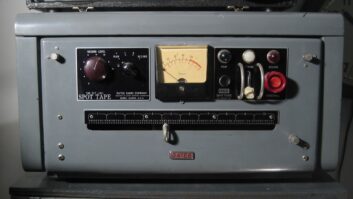One in a series of articles about the recently concluded EBU Digital Radio Summit.
When should radio leave AM and FM? Will DAB radios ever be cheap enough to woo consumers away from FM? Is IP distribution the future of radio or not?
These contentious questions were bandied about during the EBU Digital Radio Summit’s closing session, “The Great Debate: The future of radio distribution,” on Feb. 16 2022.

The Great Debate was moderated by EBU Senior Project Manager Darko Ratkaj. He began the session by asking Dr. Roland Beutler, who oversees distribution strategy at German regional public service broadcaster Südwestrundfunk, for his views on radio’s best distribution strategy.
Beutler pulled no punches in his reply. “I believe it’s necessary to shut down FM in order to reduce distribution costs,” he said. “Now the question is, how can you do that? How can you vacate the FM band, and how can you make it available to other services?”
In his home country of Germany, Beutler said that politicians need to make the case for a replacement service on the FM band that would win public support.
“One thing I could see is PPDR [Public Protection and Disaster Relief communications used by first responders], because they are using similar frequency ranges already,” he said. A second FM band user could be Smart City data services, for connecting to gas meters and other devices by radio.
Lindsey Mack was more measured when stating her view as BBC senior manager of DAB & BBC Sounds external affairs. “We do plan to close AM mid-2020s,” she said, due to a “consistent decline in listening making it really not viable, and we assume that trend will continue.”
According to Mack, the threshold for both the BBC and U.K. commercial AM stations to start winding down is when AM listenership falls to 3% of total U.K. listenership.
However, matters are not so clear when it comes to shutting down FM in Britain. “This is always a topic that causes quite a lot of alarm especially in the U.K. … and the reason for that is 36% of radio listening is still via FM,” said Mack.
“It remains really valuable to many listeners, particularly those who are older and vulnerable, and to those who may live in areas with limited DAB and/or broadband coverage, and also to the car listener where 50% of car listening is still tuned to analog,” she said.
“In terms of broadcast radio distribution, FM still dominates,” noted Peter Mac Avock, the EBU’s head of distribution, platforms and services. It also remains popular with local broadcasters as a vehicle for selling local advertising, aided by cheap, ubiquitous receivers. In fact, when the cost of FM and DAB receivers are compared head-to-head, “FM is dirt cheap,” he said.
On the other hand, DAB provides much more content variety for listeners and better advertising sales options for broadcasters, said Hanns Wolter, technical director at DAB Italia.
“If you have [targeted] local advertising, you will be able to deliver it locally [via DAB],” said Wolter. “You don’t need to go on the internet and compete with a hundred thousand IP stations. You’ll be able to get directly to your listener.”
At this point, Ratkaj stirred the pot by asking “if advocating DAB as an AM/FM replacement” and overall “good technology” actually makes much sense, given the belief that “it appears to be a transitional technology to an IP paradise — an IP-only future?”
On this point, the debaters agreed that the answer to this distribution question was not at all clear. For her part, Mack said she sees radio’s path lying in “a mixed future with broadcast and IP.”
Her uncertainty was echoed by Mac Avock. “It’s too early to call it,” he said. “It’s easy to say that it’s all going to be IP-based in the future, but there’s a whole host of problems associated with IP distribution. … IP will be a factor, for sure. How big? I don’t know.”
The only sure conclusion to be drawn from the Great Distribution Debate is that it will continue for years to come. As to whether broadcast will continue to hold its own against IP or not? Mac Avock’s summed up the current situation up nicely. “I’m not backing either horse for now.”
Related stories:
- Human Connection Draws in Younger Listeners
- In-Car Listening Influenced by More Than Music Taste
- How CBC Radio Manages Its Wealth of Digital Content
James Careless is an award-winning freelance journalist with experience in radio/TV broadcasting as well as A/V equipment, system design and integration. He has written for Radio World, TV Tech, Systems Contractor News and AV Technology among others. Broadcast credits include CBC Radio, NPR and NBC News. He co-produces/co-hosts the “CDR Radio podcast” and is a two-time winner of the PBI Media Award for Excellence.







